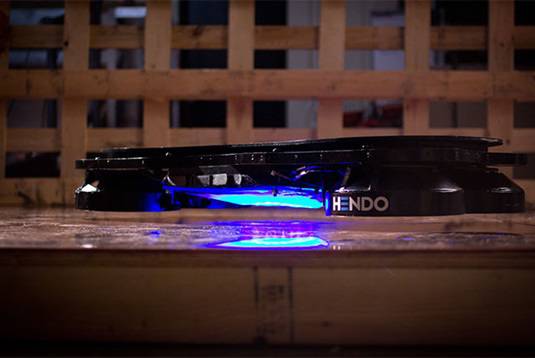This article is more than 1 year old
Back to the ... drawing board: 'Hoverboard' will disappoint Marty McFly wannabes
Buzzing board (and some future apps) leave a lot to be desired
The internet is aflutter over the Kickstarter campaign for the "Hendo Hoverboard", a magnetically levitating toy that the firm alleges will be available on October 21, 2015 – the same day that Michael J Fox programmed into the De Lorean for the second Back to the Future film.

As a consumer device it looks a little shaky
The "hoverboard" is based around the manufacturer Arx Pax's patented Magnetic Field Architecture (MFA), which is basically a fancy way of saying there are four electromagnets on the base of the board that will lift an object when placed on a non-ferrous conductive surface.
That means no skimming over hedges or pavements or anything useful like that, although the team has put together a copper skate ramp to demonstrate the technology.
The magnetic forces cause the board to float an inch above the surface and it can be steered by shifting your weight backwards and forwards or side to side. There are also plans for a handheld controller for the device as well to add steering abilities.
The downsides, aside from the aforementioned pickiness over flight surfaces, is that this all takes power. The board has batteries built in but they only last seven minutes between charges.
That's right, only seven minutes. The device also emits a loud buzzing and crackling sound during operation.
Nevertheless there is clearly demand out there, or fools with too much money. The Kickstarter campaign has only been active for a day and already has reached half of its US$250,000 goal, with five people pledging the $10,000 donation that will net them a "working" "hoverboard", and another 32 pledging $100 just to score a five-minute ride on the floating plank.
While the "hoverboard" is a cute promotional idea, the real value of the project lies in the MFA technology. Pledges of $299 or more will get investors a white box containing the system and a developer's kit, so that people can find new uses for the technology.
The inventor of MFA envisioned it as an earthquake-proofing device. The idea is that when there's a whole lot of shaking going on, a building can levitate a few inches and escape a quake's shakes, although one wonders what happens when the earthquake is accompanied by a power failure. No more house, perhaps?
But the technology also has other uses. Maglev trains are old hat these days, but very expensive due to the sensors required on both the train and the tracks. The MFA system would dramatically reduce the cost of track laying, although more details are needed to see how it would cope with emergencies.
The fact is there are a lot of potential uses of the MFA technology that are much more practical than toy "hoverboards" and preposterous floating houses. It's just a question of figuring them out. ®
